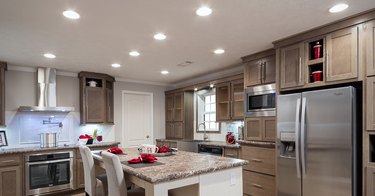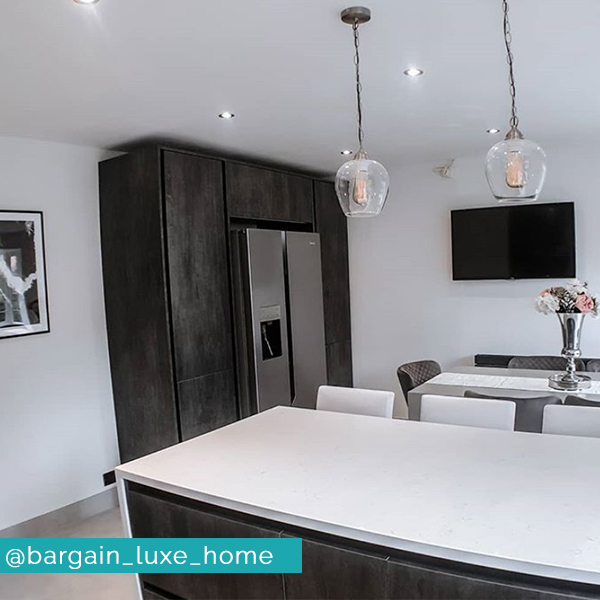Recessed Lighting in Kitchen Cost
Recessed lighting can transform your kitchen by providing a sleek, modern look while enhancing visibility and functionality. Understanding the costs associated with installing recessed lighting in your kitchen is essential for budgeting and planning your renovation project. This guide will cover the factors affecting the cost, typical price ranges, installation process, and additional considerations to help you make informed decisions.

Factors Affecting the Cost
Several factors influence the cost of installing recessed lighting in a kitchen, making it essential to consider each one when planning your budget. The first major factor is the type and quality of the recessed lighting fixtures you choose. Fixtures come in a variety of styles, sizes, and finishes, with prices ranging from affordable to high-end. Energy-efficient LED fixtures might have a higher upfront cost but can save you money on electricity bills in the long run.
Another significant factor is the complexity of the installation. If your kitchen has an existing lighting system, upgrading to recessed lighting may involve less work and cost less compared to installing new fixtures from scratch. The presence of insulation in your ceiling can also impact costs, as special IC-rated (insulation contact) housings are required to prevent overheating.
The layout and size of your kitchen will also affect the total cost. A larger kitchen requiring more recessed lights will naturally be more expensive than a smaller space. Additionally, if your kitchen layout involves complicated wiring or if there are obstacles such as beams or ductwork, the installation process will be more labor-intensive and costly.
Labor costs are another crucial component. Hiring a licensed electrician is essential for safety and compliance with local building codes. Electricians typically charge an hourly rate, which can vary based on your location and the complexity of the job. It’s advisable to get multiple quotes from different electricians to ensure you’re getting a fair price.

Typical Price Ranges
Understanding the typical price ranges for recessed lighting installation can help you set realistic expectations for your project. On average, the cost to install a single recessed light ranges from $100 to $250. This price includes the cost of the fixture itself, which can be anywhere from $20 to $150, and labor, which typically costs between $75 and $200 per hour.
For a standard kitchen, you might need between 4 to 10 recessed lights, depending on the size and desired lighting effect. Therefore, the total cost for installing recessed lighting in a kitchen can range from $400 to $2,500. This estimate covers basic installations without significant additional work.
However, if your installation requires additional features such as dimmer switches, smart home integration, or high-end fixtures, the costs can increase significantly. Dimmer switches, for example, can add $50 to $100 per switch, while smart lighting systems can add several hundred dollars depending on the technology and features you choose.
Additionally, if your kitchen requires extensive electrical work, such as updating old wiring or installing new circuits to accommodate the additional lights, you can expect to pay more. This additional electrical work can add $500 to $1,500 or more to your total cost, depending on the scope of the work required.

Installation Process
The installation process for recessed lighting involves several steps, each contributing to the overall cost and complexity of the project. The first step is planning and layout. This involves determining the number and placement of the recessed lights to achieve optimal lighting coverage in your kitchen. Proper planning ensures that the lights are evenly spaced and positioned to avoid shadows and glare.
Once the layout is finalized, the electrician will mark the spots on the ceiling where the lights will be installed. They will then cut holes in the ceiling to accommodate the light housings. This step requires precision to ensure that the fixtures fit correctly and are securely mounted. The type of ceiling material (drywall, plaster, etc.) can also impact the difficulty and cost of this step.
After the holes are cut, the next step is wiring. The electrician will run electrical wires from the existing power source to each of the recessed light locations. This involves threading wires through the ceiling and connecting them to the light housings. If new circuits or upgrades to the electrical panel are needed, this part of the process can become more complex and time-consuming.
Finally, the recessed light fixtures are installed into the ceiling. The electrician will connect the wires to the fixtures, secure them in place, and attach any trim or finishing components. Once all fixtures are installed, the electrician will test the lights to ensure they are functioning correctly and make any necessary adjustments. The installation process typically takes several hours to a full day, depending on the number of lights and the complexity of the project.

Additional Considerations
When planning the installation of recessed lighting in your kitchen, there are several additional considerations to keep in mind. One important factor is the type of bulb you will use. LED bulbs are a popular choice due to their energy efficiency, long lifespan, and lower heat output. Although they may have a higher initial cost compared to traditional incandescent bulbs, they offer significant savings on energy bills over time.
Another consideration is the aesthetic aspect of the recessed lighting. Trim styles and finishes can greatly impact the overall look of your kitchen. You can choose from various trim options such as baffle, reflector, and adjustable trims, each offering different lighting effects and styles. Select trims that complement your kitchen’s design and meet your lighting needs.
It’s also important to consider the lighting control options. Installing dimmer switches allows you to adjust the brightness of the recessed lights, creating different moods and improving energy efficiency. Additionally, consider integrating your recessed lighting with a smart home system, which offers convenient control through voice commands or a smartphone app.
Lastly, ensure that your recessed lighting installation complies with local building codes and regulations. This includes using IC-rated housings if the fixtures are in contact with insulation and ensuring that the electrical work is up to code. Hiring a licensed and experienced electrician can help you navigate these requirements and avoid potential issues.

Common Mistakes to Avoid
When installing recessed lighting in your kitchen, avoiding common mistakes can save you time, money, and frustration. One common mistake is improper spacing of the lights. Placing the lights too close together or too far apart can result in uneven lighting, creating unwanted shadows or overly bright areas. Following a recommended spacing guideline based on the size and layout of your kitchen can help achieve a balanced lighting effect.
Another mistake is neglecting to plan for insulation. If your ceiling is insulated, it’s essential to use IC-rated housings for your recessed lights to prevent overheating and potential fire hazards. Failing to do so can lead to safety risks and increased energy costs. Always check the insulation requirements before purchasing and installing your fixtures.
Improper wiring is another frequent error. Incorrectly connected wires can cause the lights to malfunction or pose a fire hazard. It’s crucial to follow the manufacturer’s wiring instructions and ensure that all connections are secure. If you’re not confident in your wiring skills, it’s best to hire a professional electrician to handle this part of the installation.
Lastly, skimping on quality can be a costly mistake in the long run. While it might be tempting to choose the cheapest fixtures and components, low-quality materials can lead to frequent replacements and higher energy bills. Investing in high-quality, energy-efficient fixtures can provide better performance and save money over time.

How much does it cost to install recessed lighting in an average-sized kitchen?
The cost to install recessed lighting in an average-sized kitchen typically ranges from $400 to $2,500. This estimate includes the cost of the fixtures, labor, and basic electrical work. The exact cost will depend on factors such as the number of lights, the type and quality of fixtures, and the complexity of the installation. For a more accurate estimate, it’s advisable to get quotes from multiple electricians.
Can I install recessed lighting myself to save money?
While installing recessed lighting yourself can save money on labor costs, it’s a challenging project that requires electrical knowledge and skills. DIY installation involves planning the layout, cutting holes in the ceiling, running electrical wires, and ensuring all connections are secure and up to code. If you’re not experienced with electrical work, it’s safer and more efficient to hire a licensed electrician. Improper installation can lead to safety hazards and potential damage to your home.
What type of recessed lighting is best for kitchens?
LED recessed lighting is generally considered the best option for kitchens due to its energy efficiency, long lifespan, and low heat output. LEDs provide bright, clear light that is ideal for task lighting in a kitchen. Additionally, they are available in various color temperatures, allowing you to choose the right ambiance for your space. When selecting recessed lighting for your kitchen, consider factors such as brightness, beam angle, and color temperature to achieve the desired lighting effect.
How many recessed lights do I need in my kitchen?
The number of recessed lights needed in your kitchen depends on the size and layout of the space, as well as your lighting preferences. A common guideline is to space the lights 4 to 6 feet apart and about 2 to 3 feet away from the walls. This ensures even lighting coverage and minimizes shadows. For task areas such as countertops and islands, additional lighting may be needed. Consulting with a lighting designer or electrician can help you determine the optimal number and placement of recessed lights for your kitchen.
Are there any additional costs associated with installing recessed lighting?
Yes, there can be additional costs associated with installing recessed lighting. These may include the cost of upgrading your electrical panel if it cannot support the additional load, installing dimmer switches or smart lighting controls, and any necessary repairs to the ceiling after cutting holes for the fixtures. If your kitchen requires significant rewiring or new circuits, this can also add to the overall cost. It’s important to factor in these potential additional costs when planning your budget for recessed lighting installation.

How to Install Under Cabinet Lighting in Your Kitchen Under cabinet lighting

Recessed Lighting Fixtures: Pros & Cons Hunker

Recessed Lighting Best Practices Pro Remodeler

LED Kitchen Cabinet Downlights Suppliers

How to Plan Recessed Lighting in Your Kitchen

Gallery AZ Recessed Lighting

Related Posts:
- Dark Kitchen Cabinets With Light Island
- Country Style Kitchen Pendant Lights
- What Color Light For Kitchen
- Flat Kitchen Ceiling Lights
- Pictures Of Kitchen Light Fixtures
- Colour Changing Led Kitchen Lights
- Home Depot Hanging Kitchen Lights
- How To Install Led Strip Lights In Kitchen
- Hanging Lights In Kitchen Pictures
- Kitchen Taps With Led Lights Australia